 |
 |
 |
| |
Entecavir vs Adefovir in HBeAg+ Naives 24 Weeks EARLY Study
|
| |
| |
Reported by Jules Levin
AASLD, Oct 27-31, 2006, Boston, MA
"Entecavir Results in Greater HBV DNA Reduction vs Adefovir in Chronically Infected HBeAg(+) Antiviral-Naive Adults:
24 Week Results (E.A.R.L.Y. Study)"
Nancy Leung1,Cheng-Yuan Peng2, Jose Sollano3, Laurentius Lesmana4, Man-Fung Yuen5, Lennox Jeffers6, Hie-Won Hann7, Morris Sherman8, Jin Zhu9, Kim Mencarini9, Richard Colonno9, Anne Cross9, Richard Wilber9 and Juan Carlos Lopez-Talavera9
1Alice Ho Miu Ling Nethersole Hospital, Hong Kong, China; 2China Medical University Hospital, Taichung, Taiwan; 3Santo Tomas University Hospital, Manila, Philippines;
4Cipto Mangunkusumo National Central General Hospital, Jakarta, Indonesia; 5Queen Mary Hospital, Pok Fu Lam, Hong Kong, China; 6University of Miami Center for Liver Diseases, Miami, Florida, USA;
7Liver Disease Prevention Center, Division of Gastroenterology and Hepatology, Thomas Jefferson University Hospital, Philadelphia, USA; 8Toronto General Hospital, Toronto, Canada; 9Bristol-Myers Squibb Pharmaceutical Research Institute, Wallingford, CT, USA
ABSTRACT
Background: Elevated HBV DNA is associated with increased risk of disease
progression and complications in patients with chronic hepatitis B (CHB). The aim of antiviral therapy is to rapidly and extensively reduce viral load (VL). We present the Week 24 results of a randomized, open-label, comparative study comparing entecavir (ETV) to adefovir (ADV) in CHB patients, and the evaluation of early viral suppression as a predictor of Week 24 results.
Methods: Sixty-nine HBeAg(+), antiviral-naive, CHB patients were randomized 1:1 to receive either ETV (0.5 mg) or ADV (10 mg) QD for a minimum of 52 weeks. Measurements of serum HBV DNA by PCR assay were obtained through Week 12 for assessment of VL reduction and viral kinetics. Additional serum samples were obtained at Week 24 for determination of HBV DNA by PCR. Evaluable patients were those who had baseline, Week 12 and Week 24 HBV
DNA by PCR and received their assigned treatment. The difference in reduction of VL between treatments was based on a linear regression model adjusted for baseline. Prediction of Week 24 VL was based on the Cochran-Armitage trend test.
Results:
Mean baseline HBV DNA was 10.26 (ETV) and 9.88 (ADV) log10 copies/mL.
ETV demonstrated superior early antiviral activity as measured by the mean reduction in HBV DNA by PCR assay from baseline at Week 12 (-6.23 vs. -4.42 log10 copies/mL, p<0.0001).
Mean HBV DNA change from baseline at Week 24 was -6.97 (ETV) vs. -4.84 log10 copies/mL (ADV). [Difference (95% CI): -1.86 (-2.51, -1.20)].
Undetectable HBV DNA (<300 copies/mL) by PCR was achieved by Week 24 in 45% of ETV- vs.13 % of ADV-treated patients.
The trend test showed that at day 10 VL was predictive of Week 24 PCR results: among those patients achieving HBV DNA <106 copies/mL by Day 10, 91% of ETV vs 50% of ADV patients subsequently achieved undetectable VL at Week 24.
Both antivirals had comparable safety profiles throughout the study.
Conclusions: At Week 24, ETV-treated patients achieved a mean 1.86 log10 (72-fold) greater reduction in HBV DNA, with a higher proportion of patients achieving undetectable VL compared to ADV. The extent of HBV DNA reduction at Day 10 was predictive of achieving undetectable HBV DNA at Week 24. Both antivirals were generally well tolerated.
Background
- Elevated HBV DNA is associated with increased risk of disease progression and complications, including HCC, in patients with chronic HBV infection (CHB)1
- Antiviral strategies should aim at rapid and extensive reduction of replication and viral load2
- ETV is a potent guanosine analogue and a selective anti-HBV agent which has demonstrated superior virologic, histologic and biochemical efficacy compared to lamivudine in phase III studies3,4
- We present a 24 Week update from the first direct comparison the efficacy of ETV vs. ADV in antiviral-naive HBeAg(+) CHB patients
Objectives
Primary
- Demonstrate ETV has superior early antiviral efficacy vs. ADV, as measured by the mean reduction in serum HBV DNA levels by Roche AmplicorTM Assay (log10 copies/ml) at Week 12 adjusted for baseline for the treatment of antiviral-naive adults with chronic hepatitis B infection
Secondary
- HBV kinetics through Week 12
- Mean HBV DNA through Week 24
- Mean HBV DNA change from baseline through Week 24
- HBV DNA level stratification at Week 12 and Week 24
- HBV DNA <300 copies/mL at Week 24 by categories of HBV DNA by PCR assay at Day 10
Study Design
- Randomized (1:1), open-label in HBeAg(+) antiviral-naive CHB patients
- ETV 0.5 mg once daily vs. ADV 10 mg once daily for up to 96 weeks
Methods
- HBV DNA assayed by Roche COBAS Amplicor PCR on days 1-14, and at Weeks 3, 4, 6, 8, 10, 12 and 24
- Kinetic profiles of ETV vs. ADV through Week 12 were compared by fitting HBV DNA data to two biphasic models:
- a 3-parameter spline model to estimate slopes
- a 4-parameter exponential decay model used to estimate effectiveness and free virus half-life3
- Sample size of at least 26 randomized patients per arm provides 90% power to demonstrate superiority in mean HBV DNA reduction from baseline at Week 12
- Efficacy analyses used the "evaluable cohort" defined as patients who received
randomized therapy for a minimum of 12 weeks and had HBV DNA measurements by PCR assay at both baseline and Week 12
- Safety data is reported for patients as-treated
Key Inclusion Criteria
- Adult males and females ≥16 years of age with chronic HBV infection
- HBeAg(+)
- No previous antiviral therapy with anti-HBV activity
- HBV DNA ≥108 copies/mL
- Serum ALT in range of 1.3 - 10 x ULN
- Compensated liver disease
- No co-infection with HIV, HCV, or HDV
Results
- Thirty-five patients were randomized to ETV and 34 to ADV. One patient randomized to ADV was treated with ETV and excluded from all efficacy analyses
- Three additional patients did not complete 12 weeks of treatment and were excluded from the evaluable cohort: One ETV patient was lost to follow-up, another ETV patient was non-compliant and one ADV patient withdrew consent
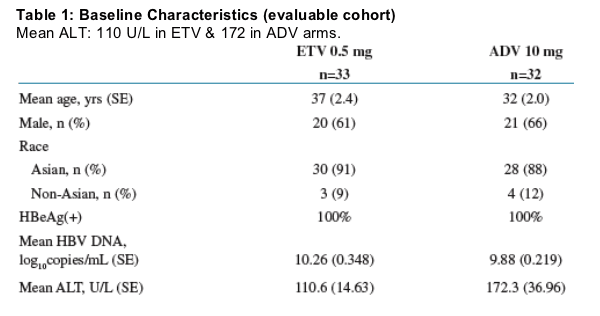
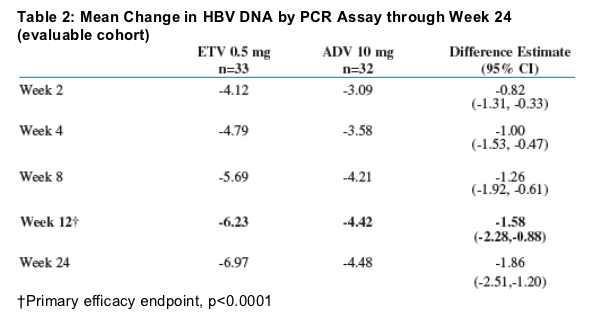
- By week 24, 75% of ETV-treated patients achieved HBV DNA less than 104
copies/mL, versus 32% of ADV-treated patients
- The proportions of patients with undetectable HBV DNA by PCR (< 300 copies/mL) at week 24 were 45% vs 13% , for ETV and ADV respectively
- At week 24, only 3% of ETV-treated patients, vs 50% of ADV-treated patients had HBV DNA > 105 copies/mL by PCR
- Treatment resulted in a biphasic decline in both treatment arms, with a first phase rapid decline lasting 10 days
- There was a higher variability of viral load reduction for ADV compared to ETV
- 95% confidence intervals of the estimated spline differences between ETV and ADV indicate ETV significantly decreases HBV DNA (log10 copies/mL) at Day 10 and thereafter, compared to ADV
- Viral kinetic profiles of ETV and ADV based on 4-parameter exponential decay
model:
-- Mean estimate of efficacy (_) was 99.9% for ETV and 99.5% for ADV, with a difference estimate of 0.41 (95% CI [0.09, 0.73]).
-- The estimated T 1/2 (mean) of circulating virus was 14.5 hours for ETV and 32.5 hours for ADV (treatment difference -17.9 hours; 95% CI [-30.7, -5.2]).
-- The treatment differences for the mean estimate of efficacy and the estimated T 1/2 of circulating virus favored ETV over ADV and were both statistically significant
- 91% of patients in the ETV group who had HBV DNA <106 copies/mL (100,000) by Day 10 went on to have HBV DNA <300 copies/mL at Week 24 compared to 50% of patients in the ADV group
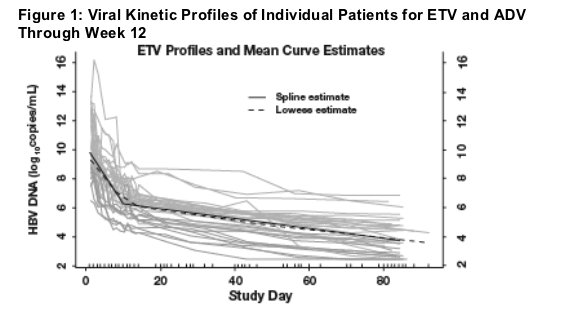
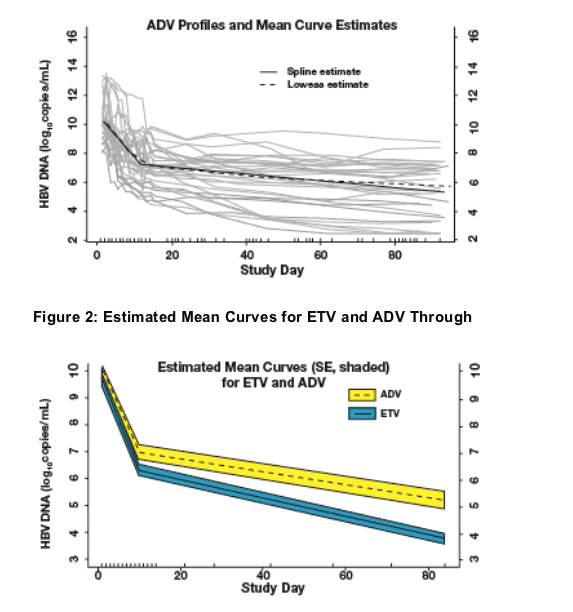
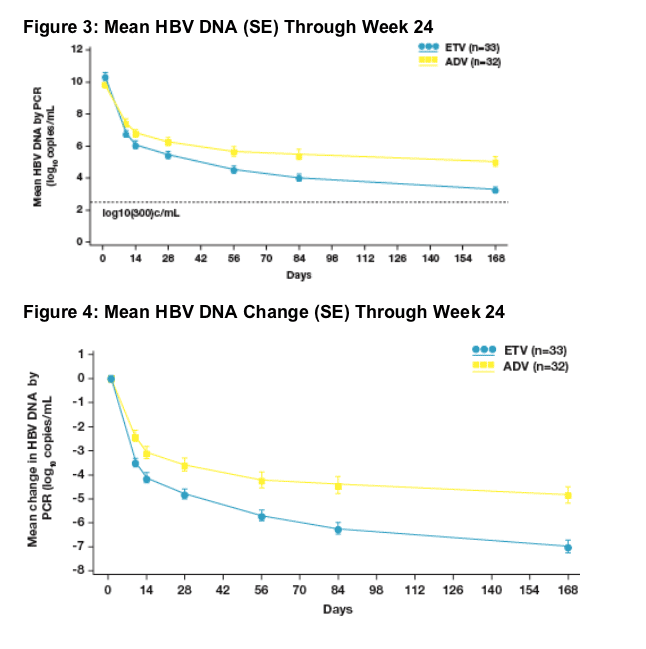
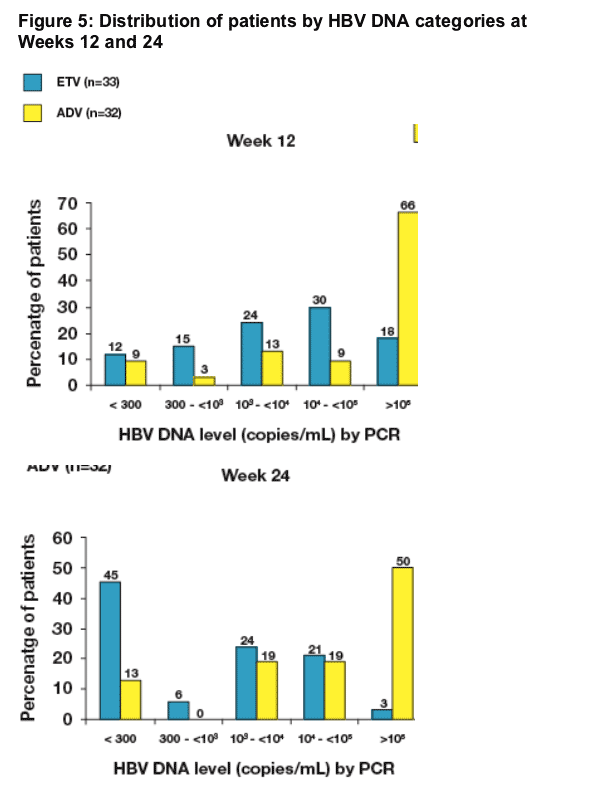
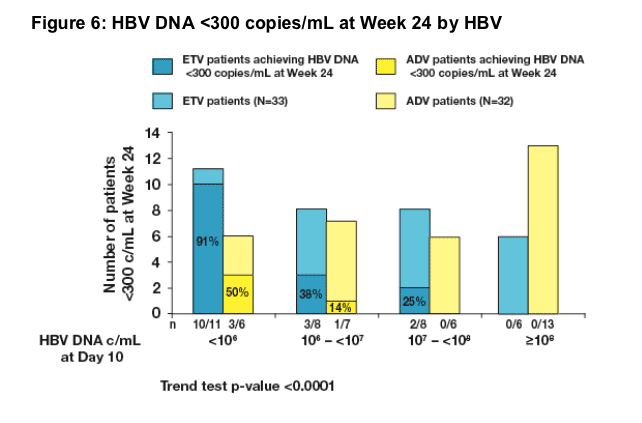
Safety
- The overall safety profiles were similar for ETV and ADV (Table 3, safety data for patients as treated)
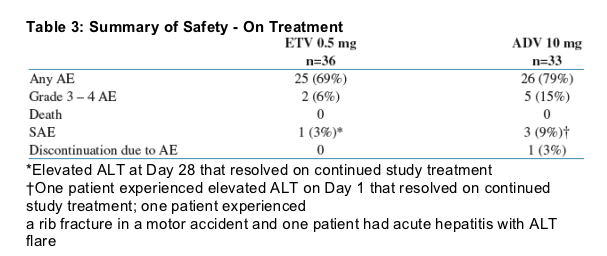
Conclusions
- At week 24, 45% of ETV-treated patients achieved undetectable HBV DNA levels compared to 13% of ADV treated patients
- ETV 0.5 mg was superior to ADV 10 mg for the primary efficacy endpoint of mean change from baseline in HBV DNA at Week 12
- A significant difference between the treatment arms in favor of ETV was reached as early as Day 10. There was a higher variability of viral load reduction for ADV compared to ETV
- Both ETV and ADV demonstrated biphasic viral kinetics, with a first phase of rapid decline lasting 10 days
- HBV DNA at Day 10 was predictive of Week 24 HBV DNA results
- ETV was safe and well tolerated
|
| |
|
 |
 |
|
|